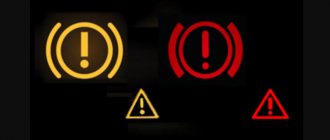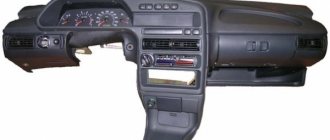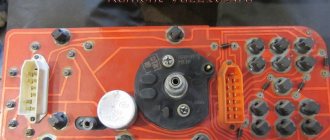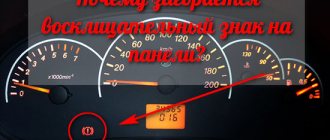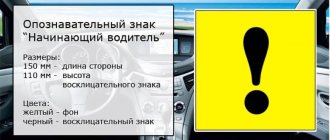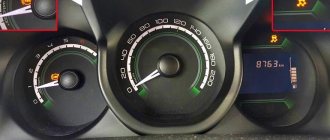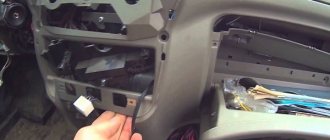What should you do if a yellow exclamation mark lights up on your car's dashboard? This question often worries car owners. It is sometimes difficult to give an unambiguous answer to this, because in cars of different brands the same problems can be displayed on the display using different signs. This means that you will have to carefully understand them so as not to find yourself at some point in a hopeless, or rather, hopeless situation.
How do indicators work differently in cars with and without ABS?
If the car has the named system, then the warning lamp (also called the indicator icon) should normally light up when the ignition is turned on and the parking brake is applied, and go out after starting the engine and when the parking brake is released. This is how the system is tested. And if the light goes out, it means the system is working properly. An indicator signal that glows longer than expected indicates a malfunction in the vehicle's systems. If ABS is not installed, then when the ignition is turned on, the icon appears only if problems arise, which we will discuss in more detail below.
So what could be causing the exclamation mark?
As we have already said, several exclamation marks can appear on the dashboards of different car brands. For example: in the yellow triangle - a signal of a malfunction in the electronic stabilization system, or in the red - the occurrence of an emergency situation, in brackets - a sign of low tire pressure (we are mostly talking about American-made cars). And if everything is clear enough with the last warning symbol, then an exclamation mark in a circle that appears on your dashboard and does not disappear during the trip may be a signal of several different problems:
- lack of brake fluid;
- violation of the integrity of the indicator circuit;
- leakage of the vacuum brake booster;
- putting the parking brake into working condition.
By the way, when the anti-lock braking system fails, the warning lights for both the brake system and ABS light up!
Location
As mentioned earlier, the red triangle is most often found in warning signs, the main purpose of which is to alert the driver to possible dangerous situations on the road. Consequently, the traffic rules describe the need to install it at a certain distance before the start of the suspicious area. Within a populated area, this value ranges from 50 to 100 meters, and outside it varies from 150 to 300 m. In some cases, additional installation of a special sign called “Distance to object” is provided, where the required value is displayed. In addition, if the dangerous area is quite long, it is also possible to install an “Area of Action” sign, which is installed under the corresponding warning symbol.
Don't forget about the information on the scoreboard!
By the way, in any case, the signs appearing on the panel are also a reason to find out the reason for the warning on the information board itself. To better understand the problem, you should open the “Machine Information” section there. To do this, you need to enter the menu and, by switching up or down, confirm your choice. This way you can find out what exactly the illuminated danger sign is telling you. As already mentioned, in some cars the exclamation mark can indicate not only defects in the brake system; in such cases, a description of the malfunction is displayed on the message display in the center of the dashboard.
How does the indicator light up when there is a lack of brake fluid?
So, to begin with, let's assume that the indicator reports insufficient brake fluid level. If this problem appears in your car, then an exclamation mark lights up on the display even while driving. Check if everything is in order and add fuel fluid if necessary. However, you should remember that later, when you have to change the pads, it can rise in the reservoir and spill. Be careful, try to suck her off with something. A rubber bulb may also be suitable for this.
Warning
Of course, in this case, it is best to find the nearest service center to check the car's braking system. By the way, on the way to an unscheduled inspection, you need to be prepared for the fact that you will have to press the pedal harder if you need to brake. And also to the fact that the free play of the said pedal will increase, as will the braking distance of your car. By the way, if the icon lights up along with the ABS indicator, then when braking, premature locking of the rear wheels is possible.
Important to remember
If any sign is located on a yellow background, this means that it is temporary. In relation to warning symbols, this may mean that the danger has arisen relatively recently, and road authorities have not yet had time to take measures to eliminate it. If you saw a red triangle on a yellow background and identified it as a priority sign, then it is likely that repair work is being carried out somewhere along your route. They were the reason for the change in movement on this section of the road. Of course, we should not forget that if there are regular and repair signs, it is imperative to comply with the requirements of the latter.
In what other cases does the exclamation mark light up?
If the fuel pressure is at a normal level, and the brake pads do not cause any complaints, but the indicator warning sign is still on on the panel, then what could this mean? In such a case, it is worth assuming that something is happening with the wiring: the system most likely began to open. If any wire leading to the pad sensor breaks, a lamp lights up, signaling their wear. In this case, of course, you can short-circuit the wires yourself, but then you will have to climb under the car every 2000-3000 km to check their condition. So it’s better to go to the service.
Fuse box
The weak link of the electric power steering on Kalina is the fuse box; if something doesn’t work, it’s worth checking them.
To get to them, you need to open the dashboard, to the left of the steering wheel. To do this, pull the top part towards you and the latch will open. Check if the fuse is working, if it fails, replace it. It is very easy to check, check the integrity of the thread inside the fuse. Changing a 50 amp relay to a 30 amp one will also help.
Newer versions of Kalina are equipped with electric amplifiers from Hyundai, which has a positive effect on its reliability. However, there are still thousands of cars with the domestic version, which malfunctions and breaks down from time to time. Now it will be easier for you to repair the electric power steering on Kalina yourself. The main thing to remember is that not every amplifier shutdown is a breakdown. And you can find the problem yourself and fix it, but somewhere you will have to go to a service center.
What you can do yourself
Try removing the connector from the cap of the reservoir where the brake fluid is located, pull off the rubber boot from it and, if it appears wet from the fluid, blow it out and wipe it clean. Check to see if the exclamation mark has gone out. Put the connector on. If the indicator lights up again, then the level sensor is most likely faulty. It happens that brake fluid gets into the middle part of the cover and closes the contacts. To do this, you need to disassemble the lid, clean and dry it. A similar operation can be done at home.
If your car has a handbrake sensor
If your car is equipped with handbrake sensors, then such a signal may be a warning about its malfunction. Problems with the handbrake cables can have the same effect. After all, it is enough to carelessly slide off the side or, when going out into nature, to “sit” on a nearby cobblestone so that the cable receives a strong load along with internal damage. It will still work for some time, but eventually the damaged area begins to become “shaggy.” And, as a result, even your muscle strength will be enough to jam the brakes using the cable (when you release it, it cannot return to its previous position, and the car goes on the brakes).
Some tips from a car mechanic
In this case, after the exclamation mark lights up, try to raise the handbrake to the maximum, but do not use much force. If you feel any play (the impression as if the handle is not secured and is simply hanging on the crossbar), then this definitely means problems with the cables. By the way, if the warning light does not come on and the rear wheels overheat when driving, then the parking brake mechanism is most likely faulty.
Hi all! Today I want to raise a rather current topic that, judging by the questions on the forums and the number of requests in search engines, worries a large number of people. I want to talk about a phenomenon where when you press the brake pedal, an exclamation mark on the dashboard lights up.
I will try to give a comprehensive answer to this question and explain why this happens and what kind of damage may be involved. Go!
Let me start, perhaps, with the fact that if a lamp (!) lights up on the panel, it means something is wrong with the brake system. As a rule, this indicator signals a low level of brake fluid (BF) in the system. As you can imagine, faulty brakes are no joke and the problem needs to be addressed. I’ll say more, if anyone doesn’t know, OPERATING A CAR WITH A BURNING INDICATOR (!) IS PROHIBITED! Since you don’t know what’s wrong and what caused this error to appear on the dashboard.
conclusions
Please note that replacing brake fluid is also necessary because, over time, it accumulates water particles from the air and becomes less effective.
The display on the dashboard is necessary to inform and warn the driver about the occurrence of various malfunctions, indicate the on/off of various functions, activation of systems, etc. Instrument panel indicator lamps are usually made in the form of icons and inscriptions of various colors (red, yellow, green, blue).
In this case, it often happens that instead of a separate icon, an exclamation mark lights up on the instrument panel. In practice, the exclamation mark icon on the dashboard may light up when you press the brake pedal, and the color of the icon may also change when the background is red or yellow. Let's figure it out.
Read in this article
What to do if the lamp comes on?
- The first thing you need to do is check the fuel fluid level. This is done simply and without any difficulties. Open the hood and look at the level, it should be between o and “MAX”. The level must be monitored constantly; for those who forget to do this, there is an exclamation mark. It lights up based on a signal from the sensor, which signals when the fuel level is below the permissible level.
By the way! There are often cases when the light comes on when driving over uneven surfaces and goes out as soon as the car drives onto a more or less level road. This happens precisely for the reason that the level of “brake fluid” is close to o and when the car is rocking, the sensor detects a low level and signals this to the instrument panel.
- If everything is in order with the brake fluid level, you need to check the fuel injection system, which is located in the brake fluid tank. I'll tell you how to do this now.
2.1. Turn on the ignition and make sure that the exclamation mark lamp comes on, that is, the indicator of insufficient fuel level. It should light up and go out if the level is normal and the sensor is working.
2.2. We turn off the power from the sensor and look at the lamp; if it goes out, most likely there is a problem with the sensor. Check the sensor, sometimes the problem is that the float fails and sinks to the bottom even though the fuel fluid level is fine.
2.3. If, after turning off the power from the sensor, the exclamation mark on the panel continues to light, most likely the problem is in the wiring, and the sensor itself is working. Perhaps the reason is a short circuit in the wiring, or something else, but one way or another the problem will be associated with a faulty wiring and a violation of its integrity.
If everything is fine with your fuel oil level sensor, but you want to check its operation, this is done quite simply
2.4. We press the rubber seal on the tank lid, so you lower the sensor float to the bottom, and in working sensors an exclamation mark on the panel lights up.
2.5. If the indicator does not light up, take a small piece of copper wire and turn off the power from the brake fluid level sensor. The prepared wire must be used to close the power contacts of the sensor, that is, the contacts on the wiring that is supplied to the sensor, and not the contacts of the sensor itself. With such a short circuit, a corresponding signal about low brake fluid level should appear on the panel. If this does not happen, most likely the sensor is working, and the problem is faulty wiring.
If the brake fluid level sensor is faulty, replace it; if the problem is in the float of this sensor, you can try to repair it; if the wiring is faulty, replace it or seek help from an experienced auto electrician.
Drivers are notified of the presence of malfunctions in various vehicle systems using icons on the instrument panel. It is not always possible to decipher the meaning of such burning icons intuitively, since not all car enthusiasts are well versed in cars. In addition, on different cars, the graphic designation of the same icon may differ. It is worth noting that not every light on the panel only indicates a critical malfunction. The indication of light bulbs under the icons is divided into 3 groups by color:
- Red icons indicate danger, and if any symbol lights up in this color, you should pay attention to the signal from the on-board computer in order to take measures to quickly resolve the malfunction. Sometimes they are not so critical, and it is possible to continue driving the car when such an icon on the panel is on, but sometimes it is not worth it.
- Yellow indicators warn of a malfunction or the need to take some action to drive the car or service it.
- The green lamps of the symbols inform about the vehicle’s service functions and their activity.
Let's sum it up
As you can see, the exclamation mark (!) on the instrument panel is lit for various reasons. Taking into account the fact that on different cars such an indicator can light up in different colors (yellow or red), it is important to be able to accurately determine the cause.
In most cases, a similar red icon in a circle means that there are problems with the brake system. The yellow color may indicate wear on the brake pads, that is, the icon of this color is informational.
If the problem element is the wiring, it is necessary to tidy up the connectors and wires. Finally, we note that sometimes the instrument panel itself may fail. Given that there are a large number of different cars, universal recommendations for removing the dashboard yourself may not be enough.
In other words, if you do not have sufficient experience, we recommend that in such a situation you contact an experienced auto electrician, completely abandoning attempts to remove the car’s instrument panel yourself. Otherwise, you can break the fasteners, break the wiring, damage individual controls, etc.
Why does the “check engine” light on the instrument panel light up: the main reasons. What should a driver do if the check light is on in the car? Useful tips and tricks.
Numbers and letters on the automatic transmission: designation of automatic transmission modes. What are the automatic transmission modes for, how and when to turn on the main and additional modes.
An engine error appeared, the check light came on: how to erase the error from the ECU memory. Available methods for resetting errors, reading and decoding engine errors.
What functions does the fuel pump relay perform, signs of breakdown. Where is the fuel pump relay installed, how to properly check the fuel pump relay.
Why does the check light light up on the dashboard? Is it possible to continue driving a car if the check engine light is on? What should you check first?
What does tire marking mean, deciphering tire markings and symbols on the tire. Basic designations, additional designations, American markings.
Warning icons on the panel
The steering wheel icon can light up in two colors. If the yellow steering wheel is on, then adaptation is required, and when a red image of the steering wheel with an exclamation mark appears, you should already be concerned about the failure of the power steering or power steering system. When the red steering wheel lights up, your steering wheel will probably become very difficult to turn.
The immobilizer icon usually blinks if the car is locked; in this case, the indicator of a red car with a white key signals the operation of the anti-theft system. But there are 3 main reasons if the immo light is constantly on: the immobilizer is not activated, if the tag on the key is not read or the anti-theft system is faulty.
The handbrake icon lights up not only when the handbrake lever is activated (raised), but also in cases where the brake pads are worn out or the brake fluid needs to be topped up/replaced. On a car with an electronic handbrake, the parking brake light may come on due to a glitch in the limit switch or sensor.
The coolant icon has several options and depending on which one is lit, draw conclusions about the problem accordingly. One red lamp with a thermometer scale indicates an increased temperature in the engine cooling system, but a yellow expansion tank with waves indicates a low coolant level in the system. But it is worth considering that the coolant lamp does not always light up at a low level; perhaps there is simply a glitch in the sensor or float in the expansion tank.
The washer icon indicates a low fluid level in the windshield washer reservoir. Such an indicator lights up not only when the level actually decreases, but also if the level sensor is clogged (the sensor contacts become coated due to poor-quality liquid), giving a false signal. On some vehicles, the level sensor is triggered when the washer fluid does not meet specifications.
The ASR icon is an Anti-Spin Regulation indicator. The electronic unit of this system works in tandem with ABS sensors. When such a light is constantly on, it means the ASR is not working. On different cars, such an icon may look different, but often in the form of an exclamation mark in a triangle with an arrow around it or the inscription itself, or in the form of a car on a slippery road.
The catalyst icon often lights up when the catalytic element overheats and is quite often accompanied by a sharp drop in engine power. Such overheating can occur not only due to poor cell throughput, but also if problems arise in the ignition system. When the catalyst fails, high fuel consumption will be added to the burning light.
The exhaust gases icon , according to information from the manual, indicates a malfunction in the exhaust gas purification system, but, as a rule, such a light starts to light after poor refueling or the presence of an error in the lambda probe sensor. The system registers misfires of the mixture, as a result of which the content of harmful substances in the exhaust gases increases and, as a result, the “exhaust gases” light comes on on the dashboard. The problem is not critical, but diagnostics are worth doing to find out the cause.
Solving the problem yourself
For those who are used to acting decisively, we can advise you to open the hood and find the electronic control unit. After disconnecting the battery, inspect the case for damage or water getting inside. If necessary, you can dry everything from excess moisture.
We check all connections in the fuse box. It is necessary to know that several fuses can be used simultaneously for ABS operation.
It is worth checking the wires going to the wheel from the ECU. They may become separated or fray during use. Such diagnostics are carried out with the car jacked up.
In some cases, it is enough to accelerate on a flat, empty road and brake sharply. In this case, all systems must work correctly, and the indicator must go out if there is a temporary failure in the ECU.
In cases where the ABS is working normally, but the lamp is still on, it is enough to remove the battery terminal for a few minutes to reset the system. Everything must return to normal.
When none of the suggested cases of putting the display in order helped, you need to boldly go to a car service center in order to identify and eliminate the error using computer accurate diagnostics.
Some car enthusiasts are afraid that when the ABS light is on, it somehow affects the operation of the braking system as a whole. They urgently begin to scour the entire Internet in search of an answer to why the ABS light is on and what to do. But don’t panic so much, the brakes on your car should be in perfect order, only the anti-lock system will not work
, which, in principle, is not critical, although in some emergency situations it helps a lot. To understand the system, I recommend reading about .
Fault indicators
The battery icon lights up if the voltage in the on-board network drops; often this problem is associated with a lack of battery charge from the generator, so it can also be called the “alternator icon”. On vehicles with a hybrid engine, this indicator is supplemented by the inscription “MAIN” at the bottom.
The oil icon , also known as a red oil can, indicates a drop in the oil level in the car engine. This icon lights up when you start the engine, and does not go out after a few seconds or may light up while driving. This fact indicates problems in the lubrication system or a drop in oil level or pressure. The oil icon on the panel may have a droplet or waves at the bottom; on some cars the indicator is supplemented with the inscription min, senso, oil level (yellow inscriptions) or simply the letters L and H (characterizing low and high oil levels).
Tidy reset
To perform the procedure, you should scroll the shield regulator until the dial is reset to zero. If you need to perform a full reset of the panel, you need to disconnect power from the battery for 15 minutes and reconnect the wires.
The Grants panel is quite advanced and easy to understand for the driver. The indicators are intuitive, making it easier for novice drivers to learn.
Specialization : Graduated from the State Automobile University, worked for 20 years at GAZ-56, now I drive a Zhiguli.
Source
